MRI: Overcoming Our Imperfections
MRI: Overcoming Our Imperfections
Oral
Oral
Acquisition, Reconstruction & Analysis
Tuesday, 14 May 2019
| Room 710B | 08:15 - 10:15 | Moderators: David Brunner, Adrienne Campbell-Washburn |
08:15 |
0440. 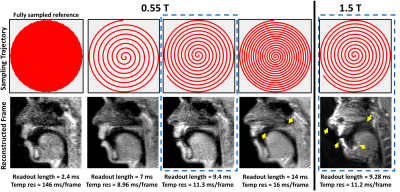 |
Dynamic speech imaging at 0.55T using single shot spirals for 11ms temporal resolution
Ipshita Bhattacharya, Rajiv Ramasawmy, Matthew Restivo, Adrienne Campbell-Washburn
Pushing the spatiotemporal resolution using spiral acquisition has been an active area of research in dynamic speech imaging. However application of long readout spirals at high field have been limited by off-resonance blurring around the mouth and airway. Low field MRI offers an advantage to speech imaging, due to reduced local susceptibility gradients. Here, we demonstrate reconstructions of single shot spiral (up to 9.4 ms readouts) without accruing any blurring artifacts resulting in high temporal resolution (11 ms) dynamic speech imaging.
|
| 08:27 |
0441. 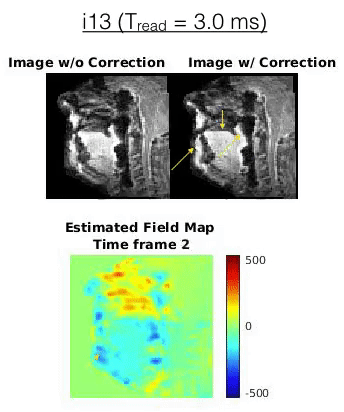 |
Improved spiral dynamic MRI of vocal tract shaping at 3 Tesla using dynamic off resonance artifact correction
Sajan Goud Lingala, Yongwan Lim, Stanley Kruger, Krishna Nayak
Spiral trajectories have been valuable in several dynamic speech production MRI studies due to its robust motion encoding, and time acquisition efficiency. However they are challenged by off-resonance artifacts at high field strengths and use of long readouts. In this work, we demonstrate correction of off-resonance induced blurring and signal losses on 3T spiral dynamic speech MRI data. The approach estimates the dynamic field map directly from the single TE data and compensates for this during a multi-frequency interpolation reconstruction. Effectiveness in improving sharpness of various articulator boundaries for long readout sequences (> 2ms) are demonstrated.
|
| 08:39 |
0442. 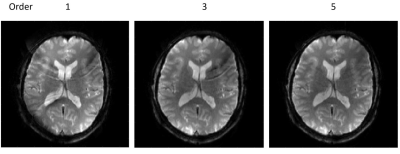 |
Echo Planar Imaging of the Human Brain with 100 mT/m Gradients
Franciszek Hennel, Bertram Wilm, Manuela Roesler, Benjamin Dietrich, Markus Weiger, Klaas Pruessmann
First results obtained with Echo Planar Imaging using a gradient insert producing 100 mT/m with 1200 T/m/s slew rate are reported. High-resolution single-shot images of human head with a very low level of distortion and blur were obtained without the need of high parallel acceleration. However, at these extreme gradient strengths, high-order fields produced by eddy-currents require special measures to avoid spatially modulated “Nyquist ghosts”. Our strategy consisted of multi-position monitoring of eddy-current fields, fitting these results with 5th-order spherical harmonics, and including this model in the signal encoding matrix inverted during reconstruction.
|
08:51 |
0443. 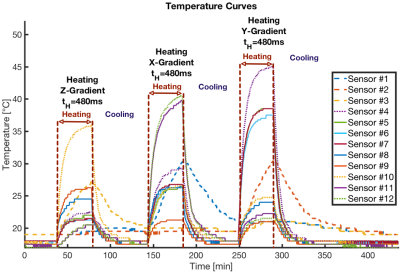 |
Temperature-dependent Gradient System Transfer Function (GSTF)
Manuel Stich, Christiane Pfaff, Tobias Wech, Anne Slawig, Gudrun Ruyters, Andrew Dewdney, Ralf Ringler, Thorsten Bley, Herbert Köstler
The gradient system transfer function (GSTF) characterizes the frequency transfer behavior of a dynamic gradient system and can for example be used to correct non-Cartesian k-space trajectories. This work analyzes the impact of the gradient coil temperatures on the GSTF by applying gradients with high amplitudes at extensive duty cycles. The obtained results show that heating changes the transfer characteristics of the system. Based on these findings, we developed a model to predict the self- and B0-terms of the GSTF in dependency of the temperature.
|
09:03 |
0444. 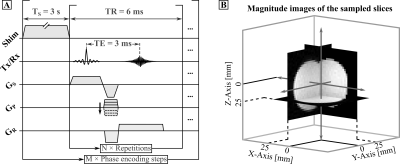 |
Fast 4D model based eddy current characterization for shim pre-emphasis calibrations
Michael Schwerter, Markus Zimmermann, N. Jon Shah
Eddy current characterizations are needed for pre-emphasis implementations in dynamic shimming applications. However, since a high spatio-temporal sampling of the eddy current fields is required, this a challenging task. Image-based approaches are well-suited for this purpose, but require substantial acquisition times.
This work presents a 2D image-based sampling scheme, which is fast compared to existing 3D techniques and still provides sufficient information for an unambiguous pre-emphasis parameter reconstruction. Moreover, a model-based fit is proposed, which jointly applies the spatial and temporal eddy current model to the acquired data. It is shown, that this approach is well-suited for reducing fitting noise. |
09:15 |
0445. 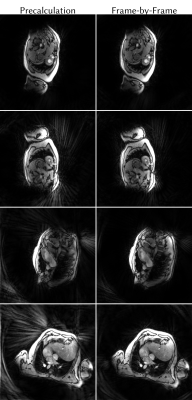 |
Simple Auto-Calibrated Gradient Delay Estimation From Few Spokes Using Radial Intersections (RING) for Interactive Real-time MRI
Sebastian Rosenzweig, H. Christian M. Holme, Martin Uecker
Radial k-space trajectories are popular for fast imaging but come at the expense of a high sensitivity to system imperfections such as eddy currents and gradient delays. Current gradient delay compensation strategies often demand calibration scans or many spokes for auto-calibration and can be computationally demanding. Here, we use the novel RING approach to estimate the gradient delays for each frame of a real-time cardiac MRI measurement to reliably remove streaking artifacts, even if the slice position is changed interactively.
|
09:27 |
0446. 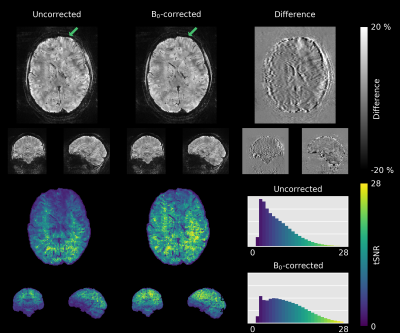 |
Correction of physiological field fluctuations in high- and low-resolution 3D-EPI acquisitions at 7 Tesla
Jolanda Schwarz, Rüdiger Stirnberg, Philipp Ehses, Tony Stöcker
Segmented gradient-echo 3D-EPI images suffer from physiologically induced field fluctuations due to long echo times and k-space data acquisition across multiple shots. In this work, the effect of 0th-order B0 correction on high-resolution and low-resolution 3D-EPI acquisitions is investigated by means of a 16-channel NMR field probe system. A clear improvement in image quality and
|
09:39 |
0447. 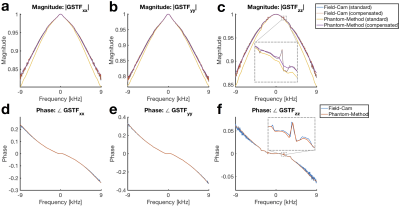 |
Dwell Time Compensation of the Gradient System Transfer Function (GSTF): Field Camera versus Phantom-based Measurement
Manuel Stich, Julian Richter, Tobias Wech, Thorsten Bley, Herbert Köstler, Adrienne Campbell-Washburn
As a linear and time-invariant (LTI) system, the dynamic gradient system can be described by the gradient system transfer function (GSTF). GSTF can be determined by special measurement equipment such as field cameras. Alternatively, phantom-based approaches were introduced as for GSTF determination without additional hardware needed. This study compares the field camera-based measurement to the phantom-based measurement and introduces a dwell time compensation. The GSTFs are applied for trajectory correction using a 3D wave-CAIPI imaging sequence.
|
09:51 |
0448. 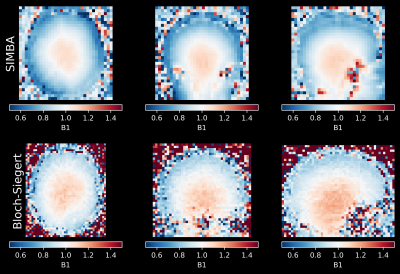 |
Silent Magnetization Prepared B1-map Acquisition - SIMBA
Emil Ljungberg, Florian Wiesinger, Ana Beatriz Solana, Gareth Barker
Characterization of the B1-transmit field (B1+) is important for many quantitative imaging techniques. Here, we present a novel, silent, B1+-mapping technique using a magnetization prepared zero-echo time 3D radial sequence. The proposed technique, named SIMBA, is shown to correspond very well to a standard 2D B1+-mapping technique (Bloch-Siegert). The efficacy of the technique is shown by correction of quantitative T1-maps obtained using the variable flip angle method.
|
| 10:03 |
0449. 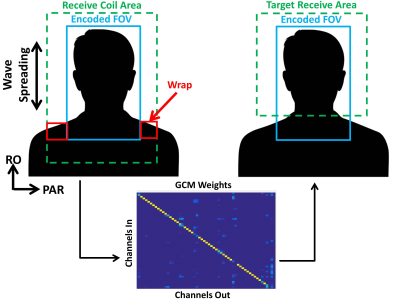 |
Geometric Coil Mixing (GCM) to Dampen Confounding Signals in MRI Reconstruction
Stephen Cauley, Daniel Polak, Wei Liu, Berkin Bilgic, Borjan Gagoski, P. Ellen Grant, John Conklin, John Kirsch, Susie Huang, Kawin Setsompop, Lawrence Wald
We introduce an artifact reduction technique that exploits the spatial locality afforded by multi-channel receiver array coils. Specifically, we create an optimal coil mixing with the purpose of dampening confounding signals prior to parallel imaging (PI) reconstruction. We demonstrate the mitigation of artifacts caused by PI model inaccuracies for Wave-CAIPI imaging in neurological and MSK applications. In addition, we illustrate the potential of this technique for minimizing the effects of non-rigid maternal and fetal motion during fetal brain imaging. This computationally efficient approach should allow for direct application of model based reconstruction/motion correction methods in difficult imaging scenarios.
|
 Back to Program-at-a-Glance |
Back to Program-at-a-Glance |  Back to Top
Back to Top